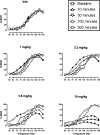Some determinants of morphine effects on intracranial self-stimulation in rats: dose, pretreatment time, repeated treatment, and rate dependence
- PMID: 21921839
- PMCID: PMC3242512
- DOI: 10.1097/FBP.0b013e32834aff54
Some determinants of morphine effects on intracranial self-stimulation in rats: dose, pretreatment time, repeated treatment, and rate dependence
Abstract
Intracranial self-stimulation (ICSS) is a procedure used to evaluate the abuse liability of drugs. The μ opioid receptor agonist morphine is an acknowledged drug of abuse, and this study examined factors that may influence expression of abuse-related morphine effects on ICSS in rats. Adult male rats were equipped with intracranial electrodes targeting the medial forebrain bundle, and 10 stimulus frequencies (56-158 Hz in 0.05 log increments) were available during each daily session under a continuous reinforcement schedule. The primary dependent variable was the ICSS rate at each frequency. Under baseline conditions, the ICSS rate increased with frequency. After acute morphine (1-10 mg/kg), rate-decreasing effects predominated at early pretreatment times (10-30 min) and rate-increasing effects predominated at later pretreatment times (100-180 min). Acute morphine effects dissipated after 300 min. Repeated morphine (3.2-18 mg/kg/day×7 days at each dose) produced tolerance to rate-decreasing effects, enhanced expression of rate-increasing effects, and enhanced rate dependency of morphine effects. Withdrawal from repeated morphine produced small but significant dose-dependent decreases in ICSS. These results show that the magnitude and valence of morphine effects on rates of ICSS in rats are strongly influenced by morphine dose and pretreatment time, history of morphine exposure, and baseline ICSS rate.
Figures





References
-
- Adams WJ, Lorens SA, Mitchell CL. Morphine enhances lateral hypothalamic self-stimulation in the rat. Proc Soc Exp Biol Med. 1972;140:770–1. - PubMed
-
- Bermudez-Rattoni F, Cruz-Morales S, Reid LD. Addictive agents and intracranial stimulation (ICS): novel antagonists and agonists of morphine and pressing for ICS. Pharmacol Biochem Behav. 1983;18:777–84. - PubMed
-
- Carlezon WA, Jr, Chartoff EH. Intracranial self-stimulation (ICSS) in rodents to study the neurobiology of motivation. Nat Protoc. 2007;2:2987–95. - PubMed
-
- Carlezon WA, Jr, Wise RA. Morphine-induced potentiation of brain stimulation reward is enhanced by MK-801. Brain Res. 1993;620:339–42. - PubMed
Publication types
MeSH terms
Substances
Grants and funding
LinkOut - more resources
Full Text Sources
Research Materials

